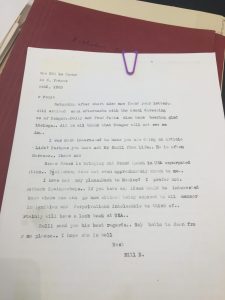
Manuscript Item: William Burroughs, “Letter to Paul from the Rue Git Le Coeur,” c. 1950s. William S. Burroughs collection, circa 1950-2004
This letter is a correspondence between William Burroughs and his friend Paul in 1960, upon Burroughs returning from Tangier. Burroughs speaks to where he desires to travel next, and does so with a sense of ambiguity. This ambiguity is somewhat pessimistic, in that he speaks badly of locations such as Mexico. Burroughs also has a sense of excitement, where locations all over the world seem to be in play for Burroughs’ next travel.
The letter also outlines how far in advance Burroughs plans. He has no idea what he will do next, but all he knows is that he won’t stay stagnant for too long. Overall, the letter outlines Burroughs’ love of travel, his desire to experience the world and feel free from the mundane that ties down the “squares” whom he speaks of, and his inability to stay stagnant for extended periods of time.
 Correspondence: Allen Ginsberg, Correspondence from Ginsberg, 1974-1975. Raymond Danowski Poetry Library collection, circa 1904-2013.
Correspondence: Allen Ginsberg, Correspondence from Ginsberg, 1974-1975. Raymond Danowski Poetry Library collection, circa 1904-2013.